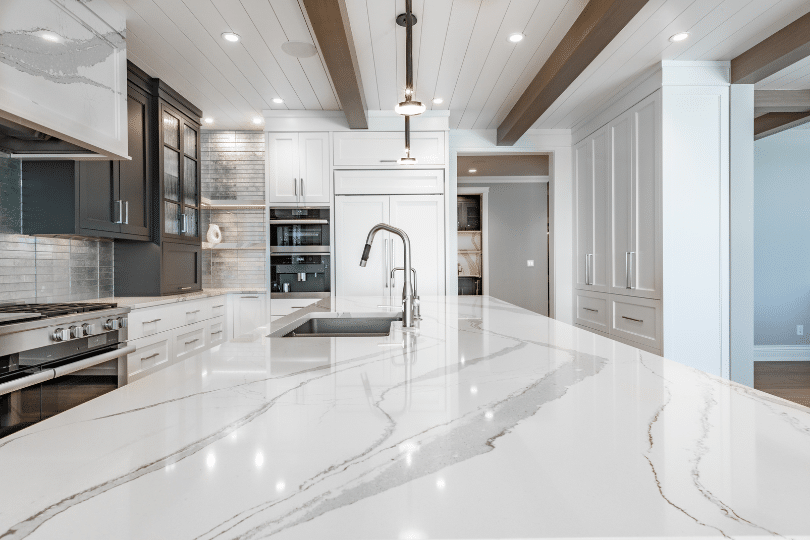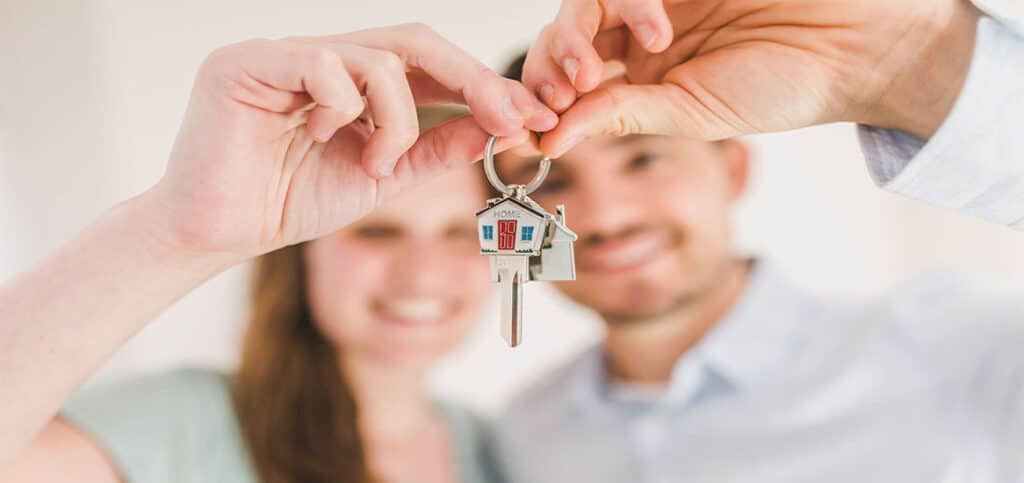Stone countertops and hardwood flooring are two of the most popular features in home design. Not only are they aesthetically pleasing, but they also increase the value of a home. Stone countertops, such as granite and marble, are known for their durability, heat resistance, and unique patterns, while hardwood flooring is a solid choice that adds warmth and character to any room. In this blog, we’ll discuss some of the best practices for caring and maintaining stone countertops and hardwood flooring so you can enjoy them for years to come.
Countertops
When it comes to choosing a countertop material for your kitchen or bathroom, stone is a popular and durable choice. There are several types of stone countertops to choose from, each with its own unique characteristics.
Granite countertops are a popular choice for homeowners due to their durability, resistance to scratches and heat, and availability in a wide range of colours and patterns. Granite is a natural stone that is incredibly long-lasting, making it an ideal material for high-traffic areas such as kitchens and bathrooms. Because of their porous texture, granite countertops require proper sealing to prevent staining from wine, juice, or oil. Additionally, while granite is resistant to scratches, heavy objects dropped on the surface can cause cracks. To maintain granite countertops, it is important to wipe up spills immediately, avoid placing hot items directly on the surface, and use a pH-neutral cleaner for regular cleaning. Regular sealing will help keep countertops looking their best.
Marble countertops are known for their elegant and timeless appearance, with unique veining patterns that add character to any space. They are also heat-resistant, making them ideal for baking and cooking. However, marble requires more maintenance than other stones due to its porous texture, which makes it susceptible to stains from acidic liquids. To prevent staining, it is recommended to seal marble countertops annually, and to wipe up spills immediately. Marble is also prone to scratches and chips, and can etch if exposed to acid for a prolonged period. While it is possible to hone marble to hide etching, it is important to use dry steel wool for light scratches and water spots.
Quartz is a popular choice for homeowners because of its durability and low maintenance. It is an engineered stone made of ground quartz, polyester resins, and pigments that give it colour. The resins make quartz countertops scratch and stain-resistant, nonporous, and antimicrobial. This means they never need to be sealed and are easy to clean. Quartz countertops are available in a wide range of colours and patterns, making it easy to find one that matches your decor. They can be expensive compared to other materials and may discolour over time if exposed to direct sunlight. High heat can also damage quartz countertops, so it is important to avoid placing hot items directly on the surface. To maintain quartz countertops, it is recommended to wipe up spills immediately and use a pH-neutral cleaner for regular cleaning.
Soapstone is a unique, durable, and environmentally-friendly option for homeowners looking for a rustic look in their kitchen or bathroom. It is made from steatite stone, which includes dolomite, magnesite, and chlorite. While softer than granite or quartz, soapstone does not crack easily. It is also non-porous, making it resistant to stains and bacteria. However, soapstone is prone to scratches and dents, and because it’s a rare natural stone, it comes with a bigger price tag than other materials. To maintain soapstone countertops, it is important to clean up spills immediately, avoid using abrasive cleaners, and apply mineral oil to the surface every few weeks.
Things to Keep in Mind
By following these guidelines, you can help keep your stone countertops looking beautiful and in good condition for years to come:
- Avoid placing hot pans or pots directly on the countertop surface. Always use a trivet or hot pad to protect the stone from thermal shock.
- Do not cut or chop directly on the stone surface. Use a cutting board to prevent scratches and nicks.
- Avoid placing heavy objects on the countertop, as this can cause cracks or fractures in the stone.
- Do not use harsh or abrasive cleaners on the stone surface, as it can cause etching and discolouration.
- Avoid exposing the stone to acidic substances such as lemon juice, vinegar, or harsh chemicals, as this can cause etching and damage to the surface.
- Do not place wet items, such as wet towels or sponges, on the countertop for an extended period of time, as it can cause water damage or staining.
- Avoid dragging heavy or sharp objects across the countertop, as it can cause scratches and damage to the surface.
Cleaning and Removing Stains
Removing stains from stone countertops can be a challenging task, but there are a few tips and tricks that can help. First, it’s important to identify the type of stain and the type of stone to ensure that the cleaning method is appropriate. Different types of stone countertops require different cleaning methods, so always check with the manufacturer or a professional for specific recommendations. For organic stains such as coffee or wine, a mixture of baking soda and water can be effective. For oil-based stains such as grease or cooking oil, using a poultice made of baking soda and acetone can be helpful. For rust stains, a mixture of lemon juice and baking soda can be effective. For tough stains, a mixture of 12% hydrogen peroxide and baking soda might do the trick. It’s important to avoid using harsh chemicals or abrasive cleaners on stone countertops, as they can cause damage to the surface. Regular cleaning and maintenance can also help prevent stains from setting in.
Making Countertops Shine
To keep stone countertops looking shiny, start by wiping up spills immediately with a soft cloth to prevent stains and etching. Regularly clean the surface with warm water and a mild dish soap to remove any dirt or grime. Avoid using harsh chemicals or abrasive cleaners, as they can damage the stone. Instead, use a specialized stone cleaner that is pH neutral and safe for use on natural stone surfaces. To maintain the shine, periodically apply a stone sealer to protect the surface from stains and etching. Finally, use a soft, dry cloth to buff the surface after cleaning to restore its natural shine.
Hardwood Flooring
Hardwood flooring is a popular choice for homeowners due to its durability, timeless appeal, and ability to increase the value of a home. There are several types of hardwood flooring available, including solid hardwood, engineered hardwood, and laminate hardwood.
Solid hardwood is made from a single piece of wood and is the most traditional type of hardwood flooring.. Red oak, white oak, maple, hickory, and cherry are among the most popular types of hardwood flooring. Red oak is known for its warm, reddish-brown hue, while white oak has a more neutral, beige tone. Maple is a light-coloured hardwood with a fine, uniform grain pattern, while hickory is a harder, more durable wood with a distinctive, rustic look. Cherry is a softer wood with a reddish-brown colour that darkens over time. Other types of hardwood flooring include walnut, birch, and ash, each with their own unique look and feel. Whether you prefer a classic, traditional look or a more modern aesthetic.
Engineered hardwood is a popular choice for homeowners who want the look of hardwood without the high cost and maintenance. Unlike traditional hardwood, engineered hardwood is made up of multiple layers of wood veneer and plywood that are bonded together with a strong adhesive. This construction makes it more resistant to moisture and warping, making it ideal for homes with kids or pets. With a wide variety of finishes and styles available, engineered hardwood is a great option for those who want the beauty of hardwood with added durability and versatility.
Laminate hardwood is made from a high-density fiberboard core with a photographic layer on top, and designed to mimic the look of hardwood, stone, or tile. It is highly durable and resistant to scratches, stains, and fading, making it ideal for high-traffic areas. With a wide variety of finishes and styles available, laminate flooring is a great option for those who want the beauty of hardwood without the high price tag. Plus, its low-maintenance needs make it a great choice for busy households.
Cleaning
Cleaning hardwood flooring is important to maintain its beauty and durability. For high-traffic areas, it’s recommended to sweep or vacuum the floor daily to remove any dirt or debris that could scratch the surface. For low-traffic areas, it’s recommended to sweep or vacuum the floor once or twice a week. It’s also important to clean up spills immediately to prevent them from seeping into the wood and causing damage. It’s recommended to deep clean the floor every 3-6 months using a hardwood floor cleaner and a slightly damp mop.
Cleaning hardwood flooring requires the right tools and cleaners to ensure that the surface is properly cleaned without causing any damage. The best tools for cleaning hardwood flooring include a soft-bristled broom, a microfiber mop, and a vacuum cleaner with a hardwood floor attachment. When it comes to cleaners, it’s important to avoid using harsh chemicals that can strip the finish or damage the wood. Instead, opt for a pH-neutral cleaner specifically designed for hardwood floors. Some popular options include Bona Hardwood Floor Cleaner, Method Squirt + Mop Wood Floor Cleaner, and Black Diamond Wood & Laminate Floor Cleaner.
To keep hardwood flooring looking beautiful and in good condition, it’s important to clean and maintain it regularly. Start by sweeping or vacuuming the floor to remove any dirt or debris that could scratch the surface. Then, use a damp mop with a hardwood floor cleaner to clean the surface. Avoid using excessive water, as it can damage the wood. Instead, use a slightly damp mop and dry the surface immediately afterward. It’s also important to protect the surface from scratches and dents by placing felt pads under furniture legs and avoiding wearing high heels or shoes with cleats on the floor. Finally, periodically refinish the surface to restore its natural shine and protect it from wear and tear.
How to Make Hardwood Floors Shine
Start by giving your floors a thorough cleaning to remove any dirt, dust, or debris that may be dulling their natural luster. Once your floors are clean and dry, apply a hardwood floor polish or wax to restore their shine and protect them from future damage. Be sure to follow the manufacturer’s instructions for best results, and avoid using too much polish or wax, which can leave a sticky residue and attract more dirt and debris.
Dehumidifier
Investing in a dehumidifier can be a wise choice to protect your hardwood flooring and improve indoor air quality.High humidity levels can cause hardwood floors to warp, buckle, or cup over time, leading to costly repairs. By using a dehumidifier, you can maintain a consistent humidity level in your home and prevent damage to your hardwood floors. Additionally, dehumidifiers can also help reduce allergies by lowering the humidity and preventing mold and other organisms from growing. Not only will a humidifier help maintain the beauty of your hardwood floors, but it can also save you money in the long run by preventing costly repairs due to humidity-related damage.
To ensure you never miss home maintenance tips and tricks from us, follow us at @cachetcommunities on Instagram.








